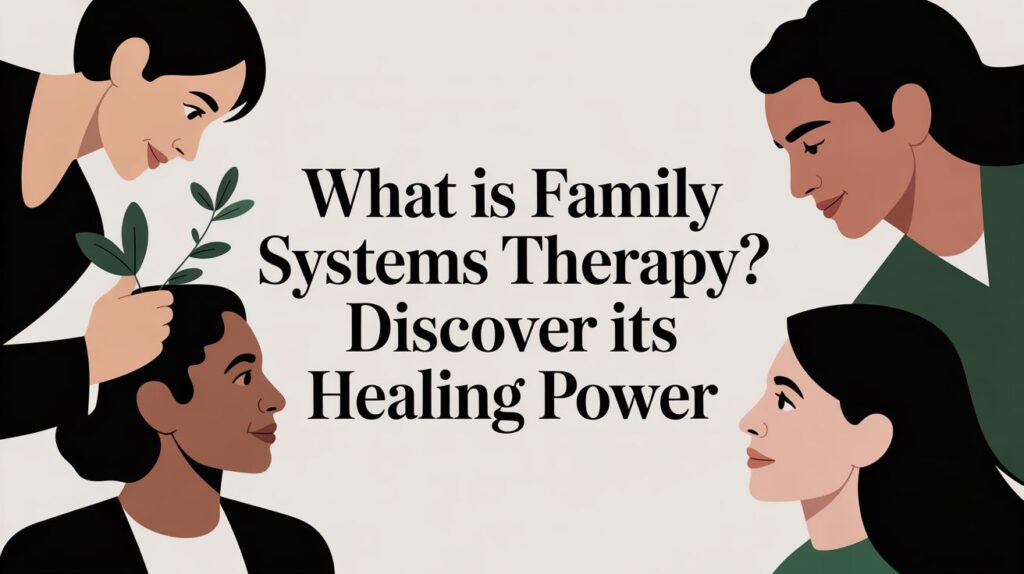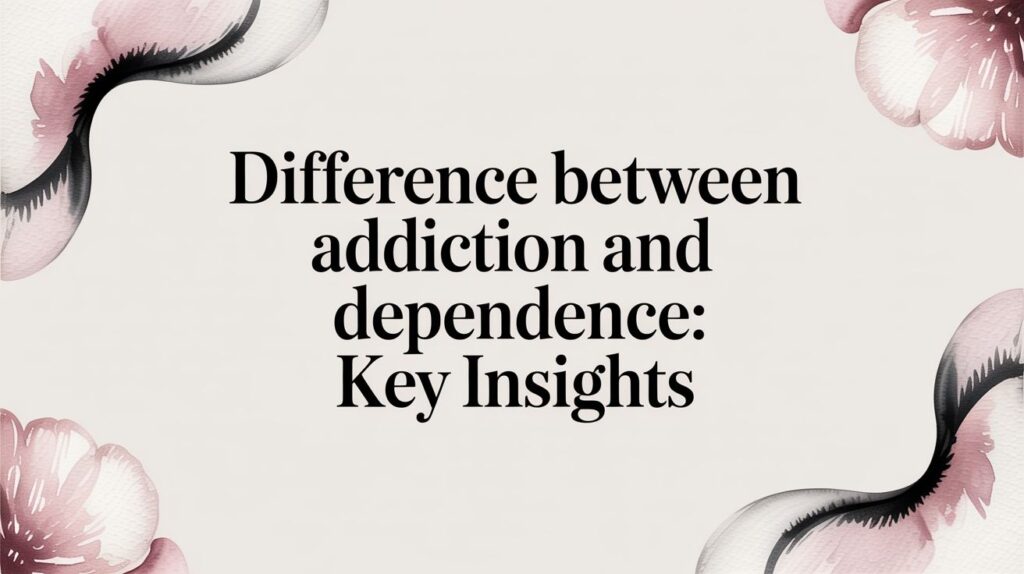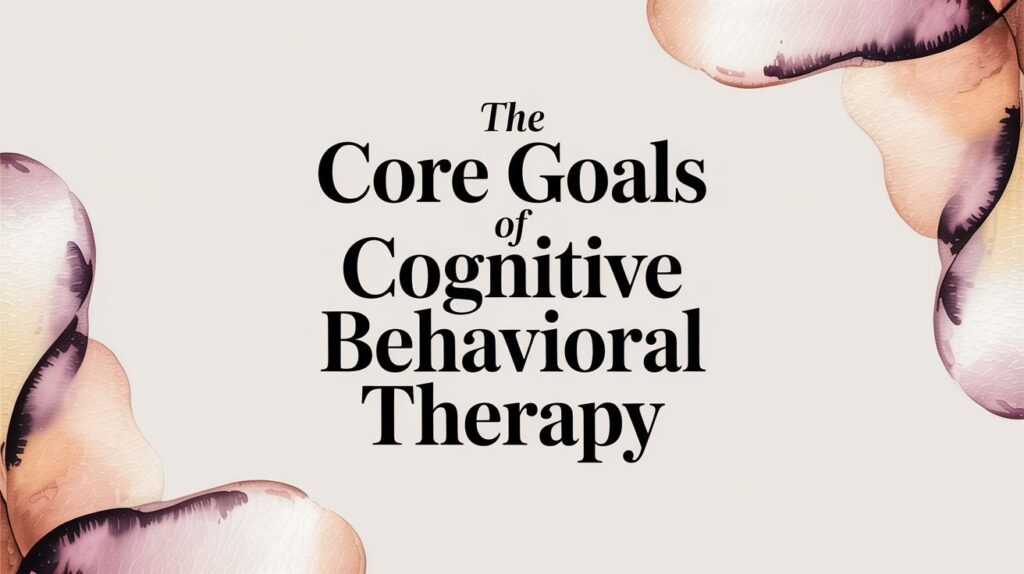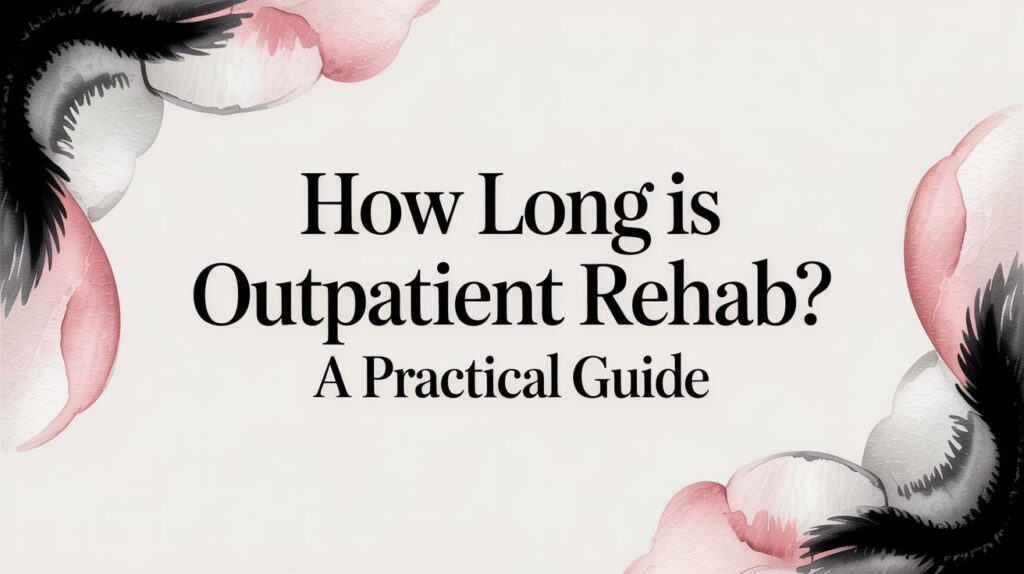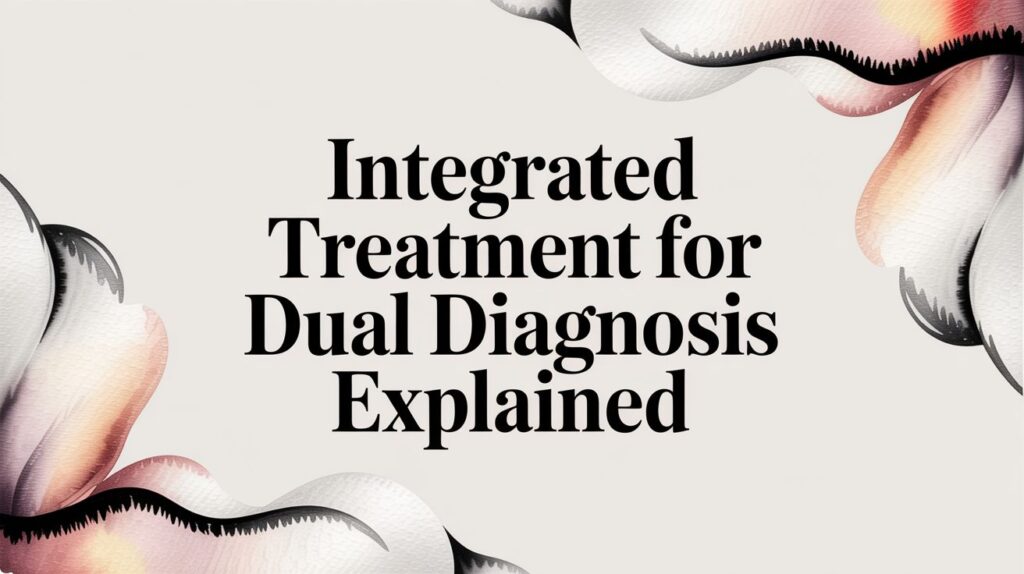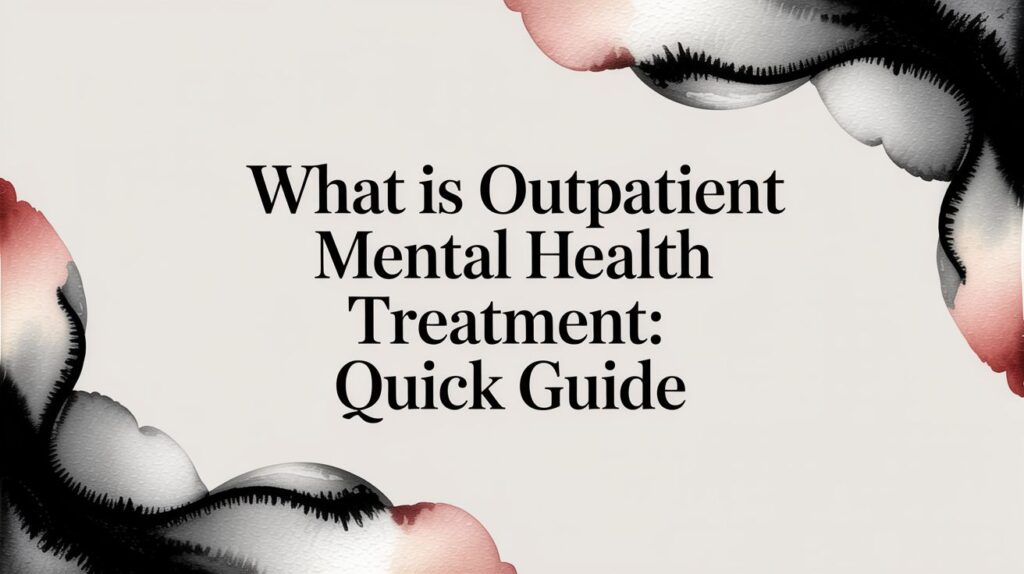Family systems therapy is an approach that flips the script on traditional treatment. Instead of seeing a person's problems in isolation, it views them within the context of their entire family unit. The focus shifts from just one person to the web of interactions and relationships that shape everyone's behavior.
Understanding the Core Idea of Family Systems Therapy
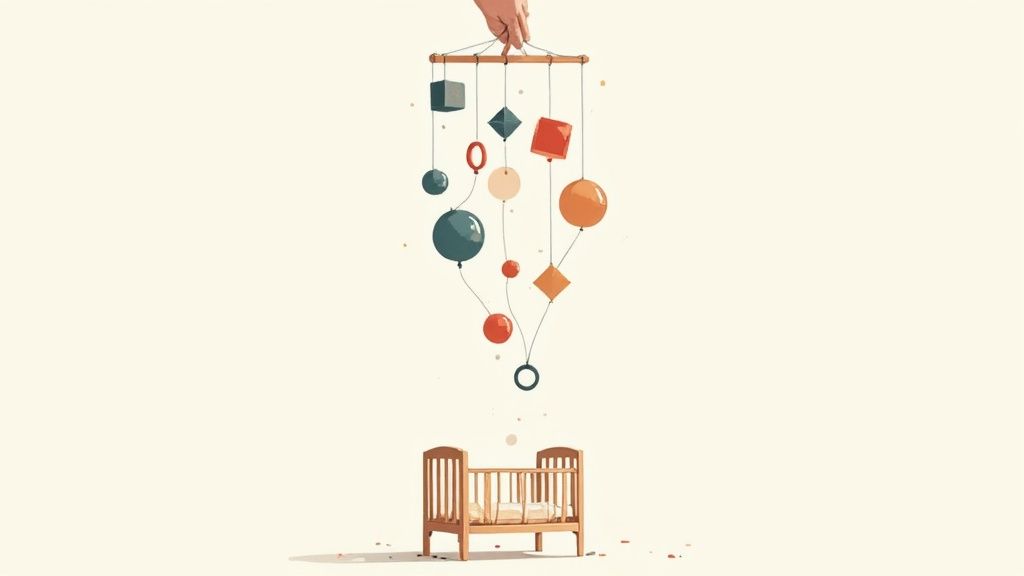
To really answer the question, what is family systems therapy, you have to change your camera lens. Most therapy zooms in tight on an individual and their internal world. Family systems therapy zooms out to capture the whole landscape—the entire family dynamic.
Think of a mobile hanging over a crib. If you touch one of the little hanging animals, all the other pieces shift and sway in response. No single piece moves on its own. A family works the same way; it’s an interconnected system where one person’s actions, feelings, and struggles ripple out and affect everyone else.
Moving Beyond Blame
One of the most powerful shifts this therapy offers is moving away from finding a "problem person." Instead of blaming a teenager for acting out or a parent for their anxiety, it examines the family's overall dynamics.
Often, the person with the most obvious symptoms is seen as the system's "symptom bearer." They are essentially the alarm bell, signaling a bigger imbalance or stress within the group. This perspective is a huge relief for families caught in a cycle of blame, helping them see the issue not as one person's fault but as a product of their shared environment.
The goal isn't to assign blame. It's to uncover the unspoken rules, communication patterns, and roles that keep the family stuck. By bringing these dynamics into the light, the whole system can learn healthier ways of relating to one another.
Identifying Hidden Patterns
Every family operates on a set of rules and patterns, many of them completely unspoken. Family systems therapy is like turning on the lights so everyone can finally see them. For instance:
- Communication Styles: Is communication direct and open, or are certain topics—like money or feelings—strictly off-limits?
- Family Roles: Has one child slipped into the role of the "peacemaker," another the "scapegoat," and a third the "hero" who can do no wrong?
- Emotional Boundaries: Are family members too tangled up in each other's lives (enmeshed), or are they so distant and disconnected that they feel like strangers (disengaged)?
Once these unconscious patterns become conscious, the family gains the power to change them. This creates a chance for healing not just for one person, but for the entire unit, building a more supportive and resilient family foundation for the future.
The Origins of Viewing Families as a Whole
Why did therapists stop focusing solely on one person and start looking at the whole family? The answer isn’t found in a single eureka moment, but in a frustrating pattern that forward-thinking therapists began noticing in the 1950s.
Pioneers in the field, like Dr. Murray Bowen, saw something baffling happen over and over again. A patient would make incredible progress in a hospital, showing clear signs of getting better. But the moment they went back home to their family, the old symptoms and unhealthy behaviors would rush back in. They’d relapse, fast.
This wasn’t a coincidence. It was a giant clue suggesting the problem wasn't just inside the person. Something in the family environment itself was keeping the issue alive.
A New Way of Seeing People
This observation kicked off a radical change in perspective. Instead of viewing a person's struggles as a purely internal problem, therapists started to see the family as a single, interconnected emotional unit. They borrowed ideas from systems theory—a concept used in biology and engineering to understand how different parts work together—and applied them to human relationships.
The core insight was powerful: a family isn't just a group of people under one roof. It's a complex, self-regulating system with its own unspoken rules, roles, and emotional currents that shape every single member.
This new lens gave therapists a map to understand how families actually operate. They could see how one person's actions triggered chain reactions in others, creating feedback loops that either kept the family stuck or helped it grow. This approach started taking shape in the 1950s as a direct response to the limitations of older psychoanalytic methods.
By 1966, Bowen’s theory, which framed the family as an emotional unit, was formally published, cementing the systemic view in therapeutic practice. You can find more details about the start of family therapy on influencetherapy.com.
The Problem Is the Pattern, Not the Person
This shift laid the foundation for what we now call family systems therapy. The focus moved away from "fixing" an individual and toward changing the dysfunctional patterns humming along within the family.
This new thinking sparked critical questions that therapists began to ask:
- How does this family show it's under stress?
- What unspoken roles do different members play to keep things stable, even if it’s an unhealthy stability?
- How are patterns from grandparents and great-grandparents still affecting this family today?
By asking these questions, therapists could help families see their own dynamics for the first time. It paved the way for a more effective and lasting approach to mental wellness—one that understands that true healing often requires the entire family system to grow and change together.
Core Principles That Drive Systemic Healing
Family systems therapy is built on a handful of powerful ideas that help us see the invisible forces shaping a family’s emotional life. Think of these principles as a map, guiding everyone away from the frustrating cycle of blame and toward real connection and healing.
They reveal a fundamental truth: problems that seem to belong to just one person are almost always tangled up in the entire family's way of relating to one another. Once you grasp these concepts, you'll start seeing your own family in a completely new light—not to find fault, but to uncover patterns so you can build healthier ones.
The Triangle: A Classic Family Pattern
One of the most common dynamics therapists see is triangulation. This is what happens when two people in conflict pull in a third person to stabilize their relationship or dial down the tension. It's an unconscious move, but it has big consequences.
The third person, often a child, ends up playing messenger, confidant, or just a convenient distraction. This prevents the original pair from ever having to resolve their issue directly.
For example, imagine two parents are constantly arguing. One of them might start confiding heavily in their teenage daughter, complaining about the other parent's flaws. The daughter is now stuck in the middle, feeling pressured to take sides. While this might temporarily ease the friction between the parents, it places a huge emotional weight on the child and stops the couple from learning how to actually communicate.
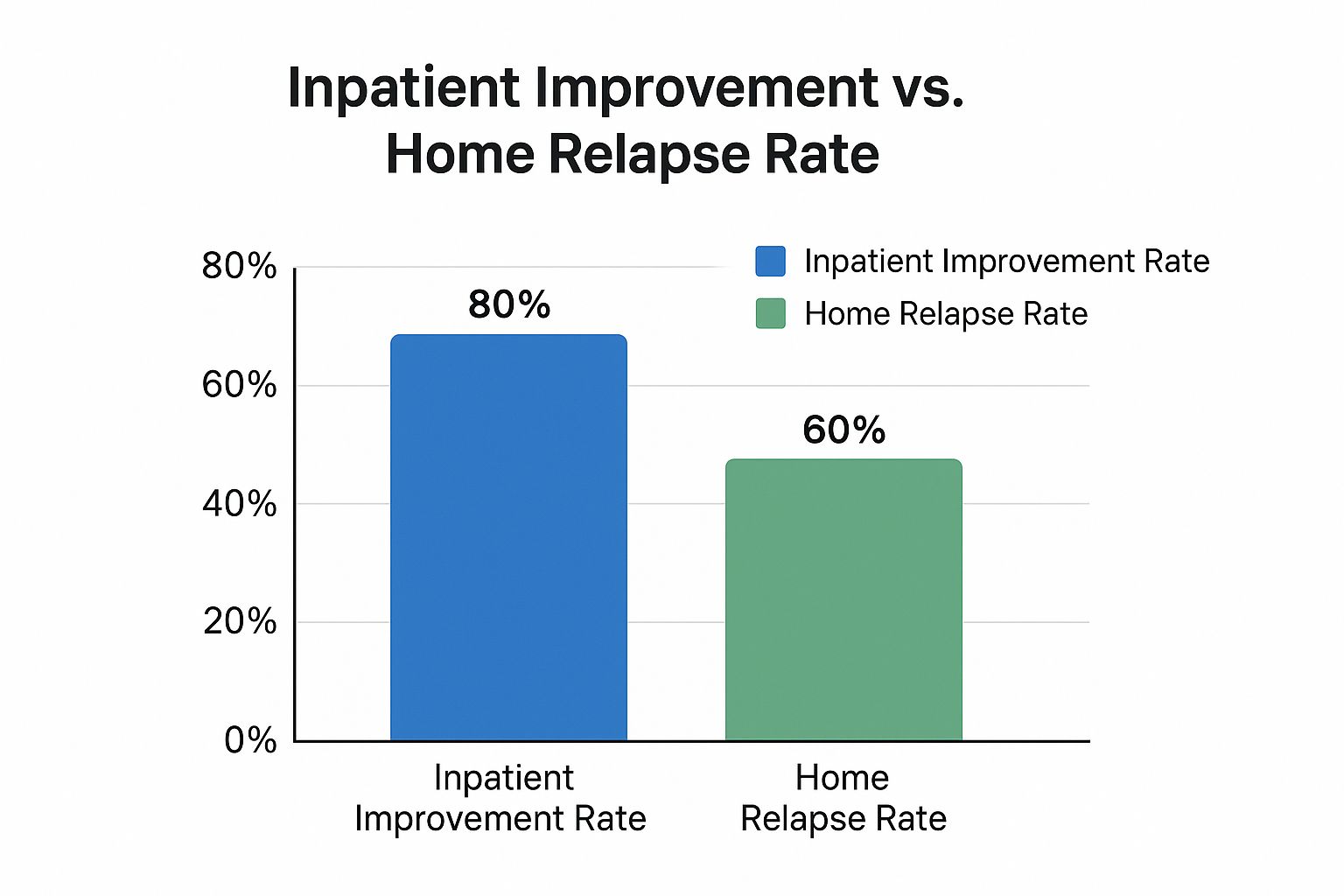
Differentiation: Finding Yourself Within Your Family
Another cornerstone principle is the differentiation of self. This is all about your ability to maintain a solid sense of who you are—your own thoughts, beliefs, and feelings—while staying emotionally connected to your family. It’s the sweet spot between being completely swallowed up by family drama and being emotionally cut off and distant.
Someone with a low level of differentiation might feel like they have to agree with everyone in the family just to feel loved or accepted. On the flip side, a person with a high level of differentiation can go home for the holidays, respectfully disagree with their uncle about politics, and leave still feeling close to him. They can be themselves and a part of the family unit.
Key Takeaway: Differentiation isn't about becoming distant or aloof. It's about developing a strong internal compass that lets you engage with the people you love without getting lost in their emotional tides.
Unpacking Common Family Roles
In many families, especially when things get stressful, members unconsciously slip into specific roles to keep the system in balance. Over time, these roles can become rigid, boxing people in and limiting their potential.
To help make these concepts more concrete, here’s a quick breakdown of the core principles we've discussed.
Core Concepts of Family Systems Therapy Explained
| Principle | What It Means | A Real-World Example |
|---|---|---|
| Triangulation | A two-person conflict pulls in a third person to reduce tension, avoiding direct resolution. | A mother complains to her son about his father instead of talking to her husband directly. |
| Differentiation of Self | The ability to be your authentic self while staying emotionally connected to your family. | You can state a different opinion at the dinner table without it turning into a fight or feeling guilty. |
| Family Roles | Unconscious parts people play to maintain the family's emotional balance. | One child is the "Hero" who always gets good grades, while another is the "Scapegoat" who gets all the blame. |
Recognizing these roles and patterns is the first step toward dismantling them and allowing everyone to show up as their authentic selves.
Some of the most common roles include:
- The Scapegoat: This person is often labeled the "problem child." They end up carrying the family's unspoken tension and absorb most of the blame.
- The Hero: This is the high-achiever who makes the family look good on the outside, often at the expense of their own emotional needs and well-being.
- The Peacemaker: This individual acts as the family mediator, constantly trying to keep everyone happy and avoid conflict, usually by suppressing their own feelings.
Seeing these roles for what they are helps family members realize they are so much more than the part they’ve been playing. This insight is especially crucial when past trauma is involved. To see how therapy can address these deep-seated patterns, you can learn more about what is trauma-informed therapy. Letting go of these roles is a critical move toward true healing.
A Look Inside a Family Systems Therapy Session
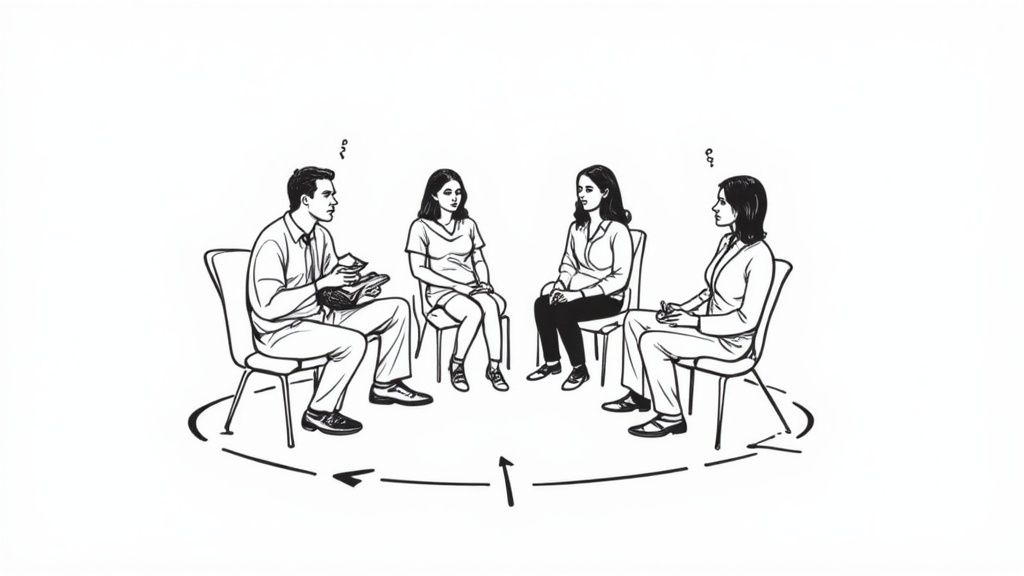
Stepping into a family systems therapy session for the first time can feel a little intimidating. That's completely normal. But you'll find the process is designed to be collaborative and eye-opening, not confrontational.
Unlike some forms of individual therapy where the spotlight is fixed on one person’s story, the therapist here acts more like an orchestra conductor. They’re listening to how each person's instrument affects the entire family symphony. The goal isn’t to “fix” one member, but to help everyone see their part in the family’s unique dance.
The therapist’s first job is to create a safe space where every single person feels heard. They observe more than just the words being said; they pay attention to the unspoken glances, the seating arrangements, and who speaks for whom. These small details are often big clues about the family's underlying structure and communication habits.
Mapping the Family Landscape
One of the first tools a therapist might pull out is a genogram. Think of it as a family tree on steroids. It’s a detailed map that charts not just who’s related to whom, but also the emotional relationships, significant life events, and behavioral patterns across several generations.
Creating a genogram together allows the family to see recurring themes in black and white. Maybe anxiety runs down the maternal line, or perhaps communication always seems to break down after a major life change. It’s a powerful exercise that takes the problem "out of the person" and places it within a shared family history, dialing down the blame game.
A genogram helps families realize that the challenges they're facing today are often echoes of patterns set in motion long ago. It’s a game-changing tool for building empathy and seeing that everyone is part of a much larger story.
Key Techniques Used in Session
During the conversation, the therapist will use specific techniques to help reveal how the family system really works. Two of the most common are:
- Reframing: This involves helping the family see a situation from a completely new angle. For example, a teenager’s rebellious streak might be reframed not as defiance, but as a clumsy attempt to find independence in a family that’s a little too close-knit.
- Circular Questioning: The therapist asks questions designed to highlight how everyone’s behavior is connected. They might ask a father, "When your son pulls away, what does your wife do?" and then turn to the son and ask, "What do you do when you see your mother react that way?"
These questions gently uncover the feedback loops that keep a family stuck in the same old cycle. While it's a group process, it's also useful to know how it differs from other therapy formats. You can explore a full comparison of individual therapy vs group therapy to get a clearer picture.
Ultimately, the therapist’s role is to guide the family toward building healthier ways of interacting, fostering stronger and more authentic connections for everyone involved.
How Systemic Therapy Supports Addiction and Mental Health
When someone is struggling with addiction or a serious mental health issue, focusing only on that person is like treating just one sick branch on a tree. They might get better for a little while, but if they go right back to the same soil—the same family environment—the old problems often find a way to grow back.
That's because families are incredibly powerful systems. The communication styles, unspoken rules, and ingrained patterns within a family can, without anyone realizing it, create the perfect conditions for addiction or anxiety to take root. For instance, a family that avoids conflict at all costs might inadvertently enable a loved one’s substance use just to keep things calm.
These dynamics are almost never intentional. A parent might take over their adult child’s responsibilities out of love, but in doing so, they strip away the natural consequences that could have sparked a desire for change. This is a classic codependent pattern, where good intentions end up propping up unhealthy behavior. Family systems therapy shines a light on these patterns so everyone can finally see them.
Building a Foundation for Lasting Recovery
Instead of zeroing in on the symptom—the addiction or the diagnosis—systemic therapy examines the entire family structure. The goal is to help the whole family shift its dynamics, creating an environment that actively nurtures recovery and well-being for everyone.
Recovery isn't just about stopping a behavior; it’s about building a new way of life. When the family joins this process, the foundation for that new life becomes incredibly strong.
Think about it: if someone returns from treatment to a home where communication still relies on passive aggression or the silent treatment, their old coping mechanisms, like substance use, can feel like the only way to survive. Therapy creates a safe, neutral space to learn a new language.
This includes learning how to:
- Set healthy boundaries without feeling guilty or fearing a fight.
- Communicate openly about difficult feelings and what you really need.
- Break cycles of enabling and replace them with genuine, supportive accountability.
- Resolve underlying resentments that have been fueling stress and disconnection for years.
By getting to the root of these dynamics, the family helps dismantle the very system that made the old behaviors possible in the first place.
The Ripple Effect on Mental Health
This approach is also remarkably effective for mental health conditions. So often, one person’s anxiety or depression is a symptom of unspoken stress within the family unit. A young adult’s severe anxiety, for example, might be deeply connected to their parents' unresolved marital tension that they've been absorbing for years. When the core family conflict is addressed, the individual's symptoms often decrease dramatically.
Many people with co-occurring disorders find their substance use is really a way to self-medicate an underlying mental health issue. Figuring out how to get support through dual diagnosis outpatient treatment is a vital step toward integrated healing. By addressing the family dynamics that fuel distress, systemic therapy gives people effective strategies to better handle relationship anxiety and find calm in their connections. Healing the system creates a ripple effect, improving everyone's mental and emotional health.
The Lasting Benefits of Healing the Family Unit
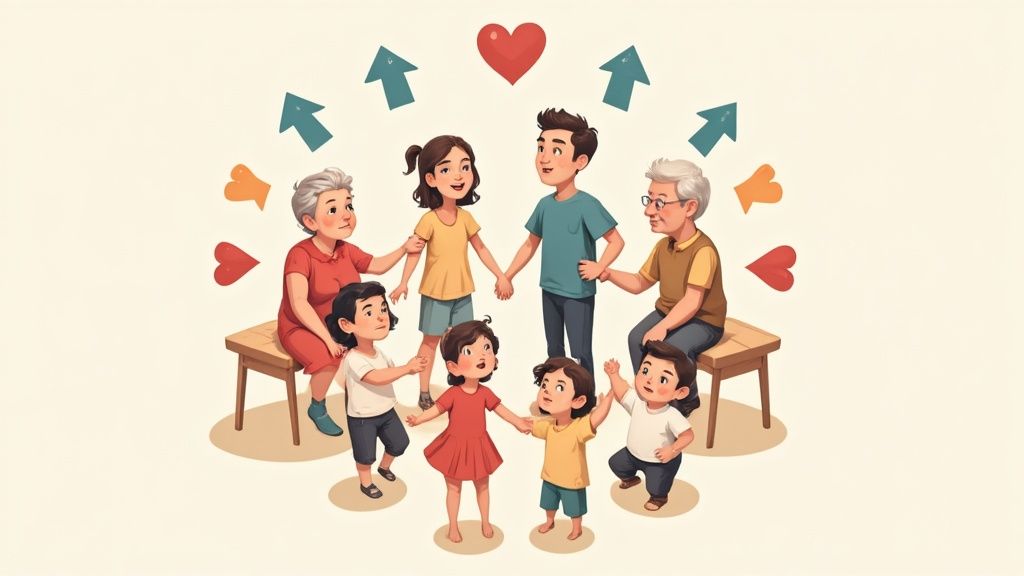
Putting in the work with family systems therapy is an investment that keeps paying off long after the sessions are over. The real-world results ripple outward, touching every member and fostering a healthier, more connected family culture for years to come.
One of the first things families usually notice is a huge improvement in how they talk to each other. Old, tired patterns of arguing, shutting down, or pointing fingers start to fade. In their place, family members learn to voice their needs clearly and listen with real empathy, which cuts down on conflict and builds much deeper bonds.
Building Resilience Together
As communication gets better, so does the family’s ability to handle whatever life throws at it. Challenges are inevitable—a job loss, an illness, or a big move can rock any family—but one that’s learned to function as a team can face these storms without falling apart.
Everyone involved develops stronger coping skills, not just for their own stress but for helping each other through tough times. This shared resilience becomes a powerful safety net. When one person stumbles, the whole system is strong enough to catch them. These skills are also invaluable for navigating big changes, like exploring strategies for making a blended family work and creating a solid new unit.
The ultimate goal is not to create a "perfect" family free of problems, but to build a functional one with the tools to resolve conflicts, support growth, and maintain connection through life’s inevitable ups and downs.
This approach has been shown to be particularly effective for adolescents with conduct disorders. Some studies report success rates as high as 60–70% compared to standard individual therapy, demonstrating the power of treating the family as a whole.
Ultimately, healing the family unit strengthens every single relationship within it. This work is vital for long-term sobriety and mental health because a supportive, stable home is one of the most important pillars of lasting change. It's a clear illustration of how deeply recovery and relationships are connected.
Common Questions About Family Systems Therapy
Deciding to start therapy is a big step, and it’s completely natural to have questions about how it all works. Getting a handle on the practical side of family systems therapy can make you feel a lot more confident about moving forward.
One of the first things people ask is whether every single family member has to show up for every single session. The short answer is no. While the goal is to involve key people, your therapist creates a flexible plan that makes sense for your family.
Some meetings might bring everyone together, but others may work better by focusing on just the parents, a few siblings, or another specific combination. It’s all about finding what will be most effective.
What if Someone Refuses to Participate?
This is a common and understandable worry. What happens when one or more family members are hesitant—or flat-out refuse—to join in? The good news is that meaningful change can start even if not everyone is on board from day one.
A skilled therapist will begin working with the willing participants. You’d be surprised how often the positive shifts made by just one part of the family system create beneficial ripple effects. This momentum can often encourage reluctant members to engage over time. The process is designed to adapt to your family’s unique situation.
Finally, families often wonder how long therapy will take. This approach is typically short-term and goal-focused, often lasting several months. The exact duration really depends on your family’s specific needs and the goals you set together with your therapist.
At Altura Recovery, we weave family systems therapy into our outpatient addiction and mental health programs because we know that healing the entire support network is key to lasting recovery. Learn how our approach can help your family by visiting https://www.alturarecovery.com.

